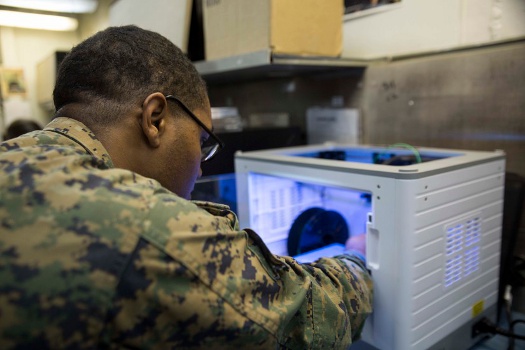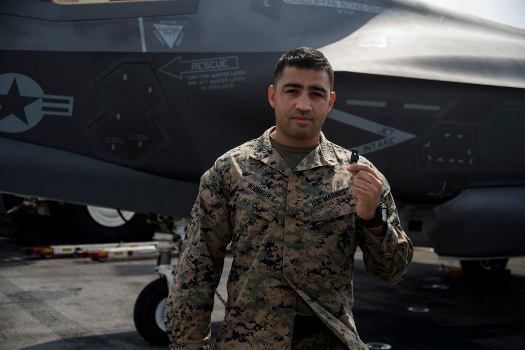 |
| August 07, 2018 | Volume 14 Issue 29 |
Designfax weekly eMagazine
Archives
Partners
Manufacturing Center
Product Spotlight
Modern Applications News
Metalworking Ideas For
Today's Job Shops
Tooling and Production
Strategies for large
metalworking plants
Marines use 3D printer to make replacement part for F-35 fighter

Marine Corps Sgt. Adrian Willis, a computer and telephone technician with Combat Logistics Battalion 31, 31st Marine Expeditionary Unit, prepares to print a 3D model aboard the multipurpose amphibious assault ship USS Wasp while underway in the Pacific Ocean, April 7, 2018. [Marine Corps photo by Cpl. Bernadette Wildes]
Marines with Combat Logistic Battalion 31, 31st Marine Expeditionary Unit, are now capable of "additive manufacturing," also known as 3D printing.
This innovative process uses 3D-printing software to break down a digital model into layers that can be reproduced by the printer. The printer then builds the model from the ground up, layer by layer, creating a tangible object.
Marine Corps Sgt. Adrian Willis, a computer and telephone technician, said he was thrilled to be selected by his command to work with a 3D printer.
3D printing is the future
"I think 3D printing is definitely the future -- it's absolutely the direction the Marine Corps needs to be going," Willis said.
The Marine Corps is all about mission accomplishment and self-reliance. In boot camp, Marine recruits are taught to have a "figure-it-out" mindset, and 3D printing is the next step for a Corps that prides itself on its self-sufficiency.
"Finding innovative solutions to complex problems really does harken back to our core principles as Marines," Willis said. "I'm proud to be a part of a new program that could be a game-changer for the Marine Corps."
The Marines deployed here use their 3D printer as an alternative, temporary source for parts. As a permanently forward-deployed unit, it's crucial for the 31st MEU to have access to the replacement parts it needs for sustained operations. The 31st MEU's mission -- to deploy at a moment's notice when the nation calls -- is not conducive to waiting for replacement parts shipped from halfway around the world. So 3D-printing capabilities dovetail with the MEU's expeditionary mandate.
‘Fix it forward'
"While afloat, our motto is, ‘Fix it forward,'" said Marine Corps Chief Warrant Officer 2 Daniel Rodriguez, CLB-31's maintenance officer. "3D printing is a great tool to make that happen. CLB-31 can now bring that capability to bear exactly where it's needed most -- on a forward-deployed MEU."
Proving this concept April 16, Marine Fighter Attack Squadron 121 successfully flew an F-35B Lightning II aircraft with a part that was supplied by CLB-31's 3D printer. The F-35B had a plastic bumper on a landing gear door wear out during a recent training mission. Though a small and simple part, the only conventional means of replacing the bumper was to order the entire door assembly -- a process that's time-consuming and expensive.

Marine Corps Chief Warrant Officer 2 Daniel Rodriguez, a maintenance officer with Combat Logistics Battalion 31, 31st Marine Expeditionary Unit, holds a 3D-printed plastic bumper for an F-35B Lightning II landing gear door aboard the multipurpose amphibious assault ship USS Wasp while underway in the Pacific Ocean, April 19, 2018. [Marine Corps photo by Cpl. Stormy Mendez]
Using a newly released process from Naval Air Systems Command for 3D-printed parts, the squadron was able to have the bumper printed, approved for use, and installed within a matter of days -- much faster than waiting for a replacement part to arrive from the United States.
‘My most important commodity is time'
"As a commander, my most important commodity is time," said Marine Corps Lt. Col Richard Rusnok, the squadron's commanding officer. "Although our supply personnel and logisticians do an outstanding job getting us parts, being able to rapidly make our own parts is a huge advantage."
VMFA-121 also made history in March as the first F-35B squadron to deploy in support of a MEU.
Making further use of the MEU's 3D-printing capability, the MEU's explosive ordnance disposal team requested a modification part that acts as a lens cap for a camera on an iRobot 310 small unmanned ground vehicle -- a part that did not exist at the time. CLB-31's 3D-printing team designed and produced the part, which is now operational and is protecting the drone's fragile lenses.
The templates for both the plastic bumper and lens cover will be uploaded to a Marine Corps-wide 3D-printing database to make them accessible to any unit with the same needs.
The 31st MEU continues to brainstorm new opportunities for its 3D printer, such as aviation parts and mechanical devices that can be used to fix everyday problems. Though only in the beginning stages of development, officials said, the 31st MEU will continue to push the envelope of what 3D printing can do in the continued effort to make the MEU a more lethal and self-sufficient unit.
Source: U.S. Marine Corps
Published August 2018
Rate this article
View our terms of use and privacy policy
